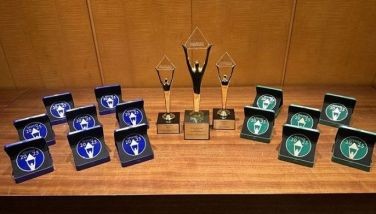Crystal balls
March 18, 2005 | 12:00am
 While the world remains enthralled by the luxurious lures of glittery jewels, glassmakers in Venice have been industriously creating another kind of precious indulgence. Murano glass, known all over the world for its quality, is the material with which the Sent sisters, scions of a glassmaking family, have been creating fine pieces of jewelry.
While the world remains enthralled by the luxurious lures of glittery jewels, glassmakers in Venice have been industriously creating another kind of precious indulgence. Murano glass, known all over the world for its quality, is the material with which the Sent sisters, scions of a glassmaking family, have been creating fine pieces of jewelry.
Situated at the Campo San Vio, a picturesque square in Venice flanked by the Grand Canal on one side and 16th-century Palazzo Cini on another, stands the small store of sisters Susanna and Marina Sent, artists in their own right who chose glass as their medium. Noted as one of the more famous representatives of the Studio Glass Movement, a trend that began in the ‘70s, the Sent sisters use glass as an expression, freed from the artistic limits of practicality and commerce. Vases lose their pretext and become singular sculptural forms, no longer simply a container but a vessel for their art.
With this in mind, Susanna, who majored in architecture, and Marina, who took up chemistry, began implementing modern designs using the same age-old handcrafting technique of free-blowing molten glass. Now their products range from clothes to purses to their much-coveted jewelry. Free from the reign of practical glassware, the Sent sisters have offered remarkable creations, like a dress made entirely of handmade glass beads woven with steel threads. The effect is startlingly ethereal, as though a floating pristine shape of a glass dress hung in thin air. Instead of appearing sharp and brittle, the effect is the opposite, with the dress’ softly inviting folds giving the appearance of luminous pliant material. This piece, of course, hangs in a museum and not in the closet of some scarily underweight fashionista.
The Sent sisters are best known for their lovely handcrafted jewelry. The Hillary necklace is their claim to fame. Strung with nylon fishing wire, these delicate glass beads hang loosely at intervals, the colored stones an homage to jocose art deco. Discovered and subsequently picked up by the gift shop of the Museum of Modern Art in New York, the necklace gained the sisters acclaim and bequeathed them the greatest compliment any artist can hope to get – imitations of the piece have sold rather well over the past decade.
Beaded concoctions by the sisters have sprouted up all over the place, like the runway of Giorgio Armani. Fans of the pair’s wearable art include Paul Smith and the Fendi sisters. Another fan found herself enamored with the original jewelry. Clarissa Oben, a lawyer, had been visiting Italy to attend the canonization of Jose Maria Escriva, the Opus Dei founder, with her husband and youngest sister. Upon crossing the Campo San Vio, Oben was transfixed by a small shop selling beautiful glassware. It was here where she first caught sight of what was to become her passion. Soon, she was returning again and again to buy loads of jewelry, until she was informed by the store’s staff that they couldn’t sell her anything else because they had showed her everything in stock.
It was then that she was informed of the sisters’ studio in Murano, the heart of the Sent sisters’ business. Everything is made in Murano. Here the glass is melted and shaped into figures that grace museums all over the world.
Upon arriving in Murano, an island in Venice, Oben was able to meet the 40-year-old sisters at their workshop, who made them feel welcome despite the language barrier. Quickly, Oben formed a partnership with the sisters who gave them rights as the only distributor of their jewelry in the Philippines. "We’ve been selling jewelry by Marina and Susanna Sent since December 2002," says Oben. "It started out – and still is – something we thought was fun to do, because we really loved the jewelry."
What’s not to like? Aside from the famed Hillary necklace, the line includes a necklace done in coral shapes, rendered in glass of course, that is stunning in the transparent version. It also comes in eye-catching hot red-orange."We think this will be the next fad," explains one of the Sent sisters to an Italian newspaper, "but we wanted to be ecological and keep the real coral under the sea, where it belongs."
"It’s interesting that they get inspiration from a lot of things," adds Oben. "When we visited them last September, we gave them a book on the Philippines and its marine life with photos of coral, fish, etc. They were very excited about the beautiful photos of the Philippines, particularly the undersea photos. Soon, they sent us a necklace for their 2005 collection named Tropical Fish."
Inspired by practically everything around them, one of their pieces sold by Oben is the Soap necklace. Presumably inspired by soap bubbles, these wonderfully round small delicate clear glass beads are a marvel to behold. Strung on the sisters’ weapon of choice, the quotidian nylon fishing string, it’s reminiscent of their glass dress – marvelously strange and playful at the same time. Its opulent simplicity a marked contrast from the heavily bejeweled fare normally on display on the heaving surgically-enhanced bosoms of society matrons. Even designer Kate Torralba was not immune to its charm, purchasing the same necklace for herself. "There’s nothing like the beautiful shapes and colors captured in Murano glass," she muses thoughtfully.""They’re too precious," she adds with a smile. "I’m collecting them for my future daughters."
Though the pieces don’t come cheap – the price ranges from P1,500 for earrings, around P2,000 for one-bead necklaces, to an average of P8,000 and up for necklaces and bracelets – these are not the kind of jewelry that loses its charm five years down the road.
"The designs are very original and innovative – not the traditional and typical jewelry from Murano," Oben relates. "The quality is also very good. But what I most like about them is that they are not dictated by fashion or by trends. The jewelry they make and design, while contemporary, is timeless."
Here’s an investment that nothing, not even large matronly jewels, can trump.
BrandSpace Articles
<
>
















